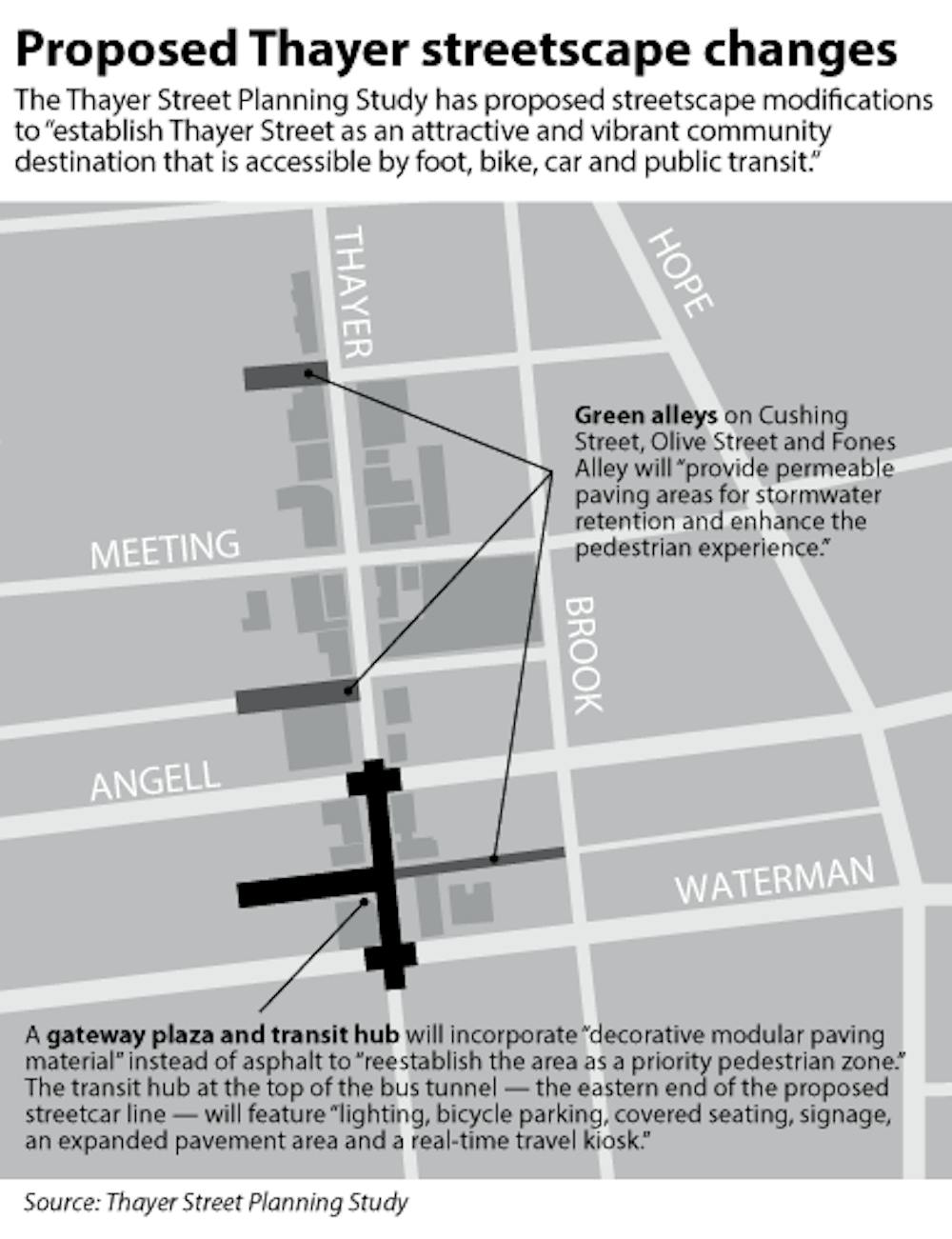Approval of the finalized Thayer Street Planning Study in late January marked the conclusion of exploratory research on potential Thayer Street improvements, signalling a transition into the plan’s implementation phase. Following months of revision, the approved outline calls for the long-term development and diversification of Thayer Street.
The plan includes just over five pages of action items for the next two years, some of which already have funding and will begin development this summer.
“I don’t think a lot has changed” during revision, said Paul Wackrow, the Providence Preservation Society’s director of preservation services, adding that he thinks the plan is “really comprehensive.”
The revision process incorporated input from a variety of stakeholder groups including the University, the Thayer Street District Management Authority, the College Hill Neighborhood Association, the Rhode Island Public Transit Authority and other groups with a vested interest in the Thayer Street district.
The addition of an implementation section is likely the most notable change made to the plan, said Nick Hornig, urban designer at NBBJ, the planning and design firm that authored the redevelopment plan. “There is no single magic bullet” that will revitalize Thayer, Hornig said. “It’s all about getting the balance right.”
Beginning this summer, students can expect to see developments, including infrastructural changes to the streetscape and integrated coordination of parking, transportation and loading, as well as the strengthening of regulatory enforcement, he said.
The creation of a parklet — parking spaces converted into a public space for people to sit — outside the Brown bookstore, which is expected to be completed by the beginning of the fall semester, will help “make (Thayer) a space for people to inhabit and feel comfortable in,” Hornig said.
Because NBBJ’s primary role was to “provide and coordinate the resources for this study,” the transition to the implementation phase marks the conclusion of the firm’s involvement. The Providence Department of Planning and Development will utilize the plan to develop Thayer in the coming years. Hornig said he hopes the smaller initiatives outlined in the project’s action plan “will be germinators of bigger change.”
The goal is to “make it more of a destination for community members,” including students and local residents, said Allison Spooner, president of the College Hill Neighborhood Association.
“Thayer Street will be re-paved this summer. … That has been on the books for a while,” said Emily Kish, principal planner for the Department of Planning and Development. When the newly re-paved roads are painted, parking lanes will be created rather than individual parking spaces. There will also be biking “sharrows” — painted symbols on a road indicating shared space for motorists and bicyclists — and new signage will be installed to ensure all traffic on the road flows one way, she added.
The entire city is being re-zoned, Kish said, which means the Thayer Street district will likely operate under new commercial zoning laws in the future. According to the re-zoning initiative’s website, the implementation phase for new zoning laws is expected to begin in the fall.
Ed Bishop ’54 P’86 P’91, chair of the Thayer Street District Management Authority and board member of the College Hill Neighborhood Association, who also owns properties in the area, said the planning study formally recommended commercial zoning for the area, which would permit the construction of buildings three to four stories tall.
New commercial ordinances for the Thayer Street district could be more accommodating to Bishop’s own proposal to build a $35 million luxury hotel on Brook Street — an effort shot down in 2004 and 2008, but still under consideration, The Herald previously reported. Bishop said he is still working on the hotel proposal, though there are challenges to attaining proper approval and raising the necessary funds.
If approved, the hotel would surely be profitable given University events such as Fall Weekend, Commencement, sports reunions and conferences, he said, citing the prestigious reputation of The Study at Yale hotel in New Haven.
Bishop said he was encouraged by the study’s proposal for “long-term economic development,” which could potentially include his hotel and new offices. The plan also calls for improved parking, but does not specify a location. Bishop said he is in favor of building an underground parking lot beneath Pembroke Field.
Thayer’s various restaurants do not “make it much of a commercial street,” Bishop said, adding that many Thayer shops used to be hardware stores, eyeglass stores and other commercial entities, not eateries. “Historically, CVS was a Thayer market,” he added.
“People would buy something for $12 on Thayer that they could get for $10 somewhere else if they had the option,” Bishop said, noting that “people like to see the neighbors in a neighborhood environment,” which means more commercial development would be economically viable and profitable for businesses.
But space will prove a constraint, since there are not many large plots available on Thayer for business development. “A good boutique market wouldn’t try for 6,000 square feet,” Bishop said, adding that 12,000 square feet or more would be more realistic for a potential storefront.
As a stakeholder interested in monitoring Thayer Street development, the Providence Preservation Society is currently “exploring funding” to conduct a preservation survey of the Thayer Street district, Wackrow said. This will help the society understand the area’s currently poorly documented history and will “help to guide future development,” he added.
“Our main responsibility is to get the survey underway,” Wackrow said. “We really want a detailed history of all the properties in the area” to help define the neighborhood’s character and determine which buildings are historically significant, he added.

ADVERTISEMENT




